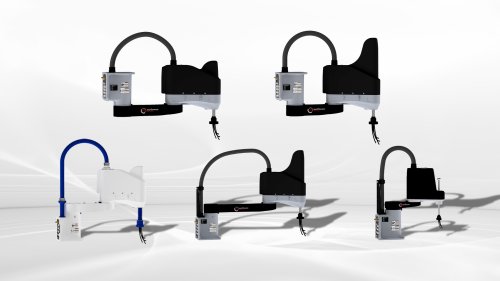

sCara Robots
Scara Robot
Introduction to SCARA robots
A SCARA robot, or Selective Compliance Assembly Robot Arm, is engineered for rapid and precise tasks within automated manufacturing environments. It features a four-axis structure with distinctive joint arrangements that enable flexible horizontal movement while ensuring vertical rigidity. Understanding how a SCARA robot works involves examining its kinematics, which governs the motion and positioning of its components. Their kinematics allow it to execute tasks with high accuracy and speed, making it ideal for assembly, packaging, and material handling operations.
The robot’s configuration enables fast and accurate execution of assembly, handling, and pick-and-place tasks. Its compact design is particularly valuable in applications such as electronics assembly, packaging, and automotive component handling. With an optimized reach and repeatability, these robots are ideal for operations that demand speed, consistency, and precision.
The robot’s configuration enables fast and accurate execution of assembly, handling, and pick-and-place tasks. Its compact design is particularly valuable in applications such as electronics assembly, packaging, and automotive component handling. With an optimized reach and repeatability, these robots are ideal for operations that demand speed, consistency, and precision.
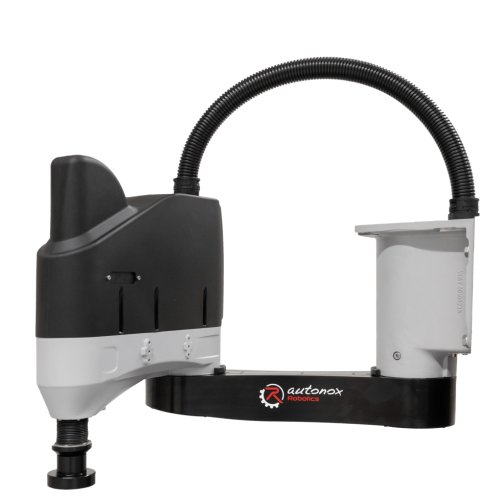
How SCARA robots work
These robots feature a unique kinematic design that allows selective compliance in the horizontal plane while maintaining rigidity along the vertical axis. Their movement is primarily defined by two horizontally rotating joints that enable fast and precise positioning in the XY plane. A vertical linear axis (Z-axis) handles lifting motions, while an additional rotary axis allows exact orientation of the end effector.
This combination of axes makes them ideal for high-speed pick-and-place operations, precision assembly tasks, and packaging processes where speed, reliability, and repeatability are critical. Their movements are precisely controlled through advanced motion controllers and integrated into production lines via industrial communication interfaces. They are known for short cycle times and high process stability, making them essential for demanding automation environments.
A key enhancement to their functionality is the integration of vision systems. They are equipped with cameras use visual sensors to accurately detect and align objects. The camera system identifies the position and orientation of parts and adjusts robot movements in real time. This significantly improves accuracy and efficiency in automated assembly, pick-and-place, and inspection tasks—especially when working with variable object positions or complex components.
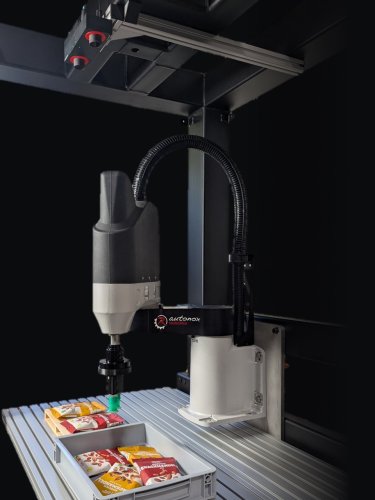
Applications of SCARA robots
They are known for their speed and precision, are essential in industrial manufacturing, excelling in tasks demanding rapid and accurate horizontal movements. The inverse kinematics robot is particularly notable for its role in the electronics industry, where it is utilized for component assembly and soldering due to the efficient robot mechanism. In the automotive sector, their working is crucial for precision assembly, screwdriving, and quality control tasks. Understanding their construction is vital when selecting a manufacturer, as it ensures the provider offers quality and innovative technology tailored to specific application needs.
In the packaging and food industries, these robots perform tasks such as sorting, pick-and-place, and the packaging of delicate products. Their robust design and modular integration make them ideal for production environments with high hygiene standards, cleanroom requirements, or protection classes (e.g., IP ratings).
In the packaging and food industries, these robots perform tasks such as sorting, pick-and-place, and the packaging of delicate products. Their robust design and modular integration make them ideal for production environments with high hygiene standards, cleanroom requirements, or protection classes (e.g., IP ratings).
Modern SCARA systems offer growing flexibility through tool-changing options, integrated media supply, and advanced control technology. This opens up new applications in plastics processing, precision engineering, and consumer goods manufacturing. Across all these industries, they ensure maximum productivity with consistent quality and process reliability, making them a key component of advanced automation solutions.
Advantages of SCARA robot
They deliver a range of technical advantages that make them highly effective in industrial automation:
High speed
The are designed for high-throughput environments, offering exceptional speed and precision. Their rigid vertical axis combined with flexible horizontal movement allows for ultra-fast and accurate pick-and-place operations. This makes them ideal for industries requiring rapid and precise automation solutions.
Compact & Modular Design
They robots require minimal space and offer multiple mounting options—floor, wall, or ceiling—making them easy to integrate into confined or complex production lines.
Integrated media supply facilitates
Integrated media supply facilitates internal routing for air, electricity, and vacuum, significantly reducing the need for external cabling. This design enhances reliability and cleanliness while extending maintenance intervals.
Operational efficiency
Optional automated tool changers enhance operational efficiency by enabling swift end-effector exchanges. This feature significantly boosts flexibility and minimizes downtime in multi-task production environments, making it a valuable asset for systems incorporating high speed scara robots. Understanding scara robot dynamics is crucial for optimizing these processes, as it ensures seamless integration and operation within diverse industrial applications.
Open control architecture
Integration with open control architecture, such as EtherCAT and PROFINET, facilitates seamless incorporation into Industry 4.0 systems. Their dynamics make them suitable for applications requiring precision and efficiency. High-speed robots, with their advanced control capabilities, are utilized in various applications to optimize production processes and maintain operational excellence.
Low Maintenance & High Reliability
With fewer moving parts and wear-resistant components, they require less frequent servicing and deliver long-term operational stability.
Kinematic efficiency
The kinematic efficiency of these robots, characterized by their distinctive arm design, effectively reduces motion paths while enhancing speed and precision in the XY plane. This attribute proves particularly advantageous in sectors such as electronics, packaging, and medical device assembly. With their high-speed capabilities, these robots are invaluable in applications requiring rapid and precise movements. The advanced SCARA robot dynamics contribute significantly to their efficiency, ensuring that high-speed robots perform tasks with exceptional accuracy and reduced cycle times.
Disadvantages of SCARA Robots
While SCARA robots provide numerous benefits, it is essential to acknowledge the robot’s disadvantages when choosing an automation solution.
Limited Range of Motion
They robots are primarily designed for tasks in the horizontal (XY) plane. Their restricted vertical (Z-axis) movement makes them less suitable for complex 3D operations or tasks requiring high vertical flexibility.
Fixed workspace
Due to their rigid arm design, the robots have a limited and predefined working area. They are not ideal for applications requiring a large or highly variable workspace.
Sensitivity to Singularities
In certain positions (kinematic singularities), the robot may face multiple possible joint configurations for the same end-effector position. Without proper programming, this can lead to positioning errors or control issues.
Less Suitable for Heavy Loads
The robots are optimized for light to medium-duty tasks. Their structure is not designed to handle very heavy payloads, unlike articulated or Cartesian robots.
Lower Flexibility Compared to 6-Axis Robots
They typically have 4 axes and cannot match the dexterity or full spatial freedom of 6-axis articulated robots, limiting their use in tasks involving complex orientations.
Application-Specific Design
While highly efficient in assembly, pick-and-place, and packaging.
They are not a one-size-fits-all solution. For applications requiring welding, painting, or curved path motion, other robot types may be more appropriate.
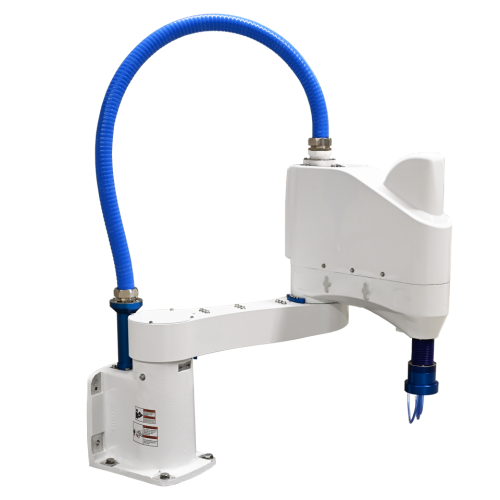
Choosing the right SCARA Robot for your needs
Selecting the right robot begins with a thorough technical analysis of the intended application. Key parameters such as payload, reach, cycle time, and repeatability must be precisely matched to your production goals. For high-speed processes, short cycle times and dynamic responsiveness are essential, whereas fine assembly tasks demand maximum precision and mechanical stability.
A crucial consideration is the mechanical design of the robot. A rigid structure combined with high-quality bearing and guide systems ensures consistent accuracy, even under high-speed operation. Equally important is the integration of media supply and tool interfaces. SCARA robots with built-in pneumatic, vacuum, or signal routing directly to the end effector reduce installation complexity and enhance operational reliability—particularly in systems using automatic tool changers.
A crucial consideration is the mechanical design of the robot. A rigid structure combined with high-quality bearing and guide systems ensures consistent accuracy, even under high-speed operation. Equally important is the integration of media supply and tool interfaces. SCARA robots with built-in pneumatic, vacuum, or signal routing directly to the end effector reduce installation complexity and enhance operational reliability—particularly in systems using automatic tool changers.
Environmental conditions must also be evaluated. Factors such as temperature, humidity, cleanroom classification, or exposure to dust require robots with specific protective features, including sealed housings, coated surfaces, or IP-rated enclosures.
Lastly, it’s important to consider long-term factors such as total cost of ownership (TCO), ease of maintenance, and the service capabilities of the manufacturer. A well-chosen robot is not only a tool for immediate productivity but also a strategic investment in reliable, scalable, and future-ready automation.
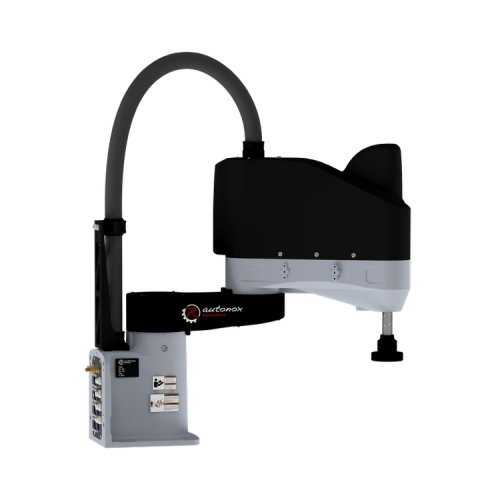
Maintenance and Troubleshooting Tips for SCARA Robots
Regular maintenance is critical for ensuring performance and reliability. Key tasks include checking and lubricating bearings, belts, and guide rails according to the manufacturer's schedule. Proper axis alignment must be maintained to preserve precision.
Inspect integrated media lines (pneumatic, vacuum, electrical) for wear, leaks, and secure connections. Tool changers should be cleaned and tested regularly to avoid interface errors.
On the software side, keep firmware and diagnostics tools up to date. Monitor industrial communication (e.g., EtherCAT, PROFINET) for stability and latency issues. Typical faults—like position drift or motion errors—often stem from encoder wear, loose components, or sensor issues. Use built-in diagnostics and log analysis to identify the cause.
Finally, ensure the robot’s IP rating suits the environment, and replace filters or seals as needed. Scheduled preventive maintenance and up-to-date documentation reduce downtime and extend system life.
sCara Robots by autonox Robotics
sCara robots from autonox Robotics stand for modular, high-performance, and easily integratable solutions in modern industrial automation. Their open kinematic platform and high degree of customization make them ideal for a wide range of applications—from precision assembly to packaging.
Technical Highlights:
Integrated Tool Changer
Models with “ATS” in the article number feature a fully integrated tool changing system for maximum flexibility.
Quadruple Media Supply
Media lines for air, vacuum, and signals are routed directly to the end effector—ideal for grippers, sensors, or actuators.
Integrated Valve Islands
Components such as valve manifolds can be built into the robot arm to save space and protect system integrity.
Flexible Cable Routing
Cable exit points are available on both base flanges—standard toward the wall, optionally downward or upward.
Versatile Mounting Options
The robots can be mounted on the floor, wall, or ceiling, provided the Z-axis module is vertically aligned.
Optimized Z-Axis
The Z-axis is built for precision and durability, with a compensation dataset (coming soon) for highly accurate positioning—ideal for complex mounting and multi-orientation setups.
As a trusted SCARA robot manufacturer, autonox Robotics combines innovative engineering with personalized support and tailored solutions. With a strong focus on quality, flexibility, and technical excellence, autonox is among the industry’s leading suppliers—delivering long-term productivity and process reliability across diverse automation sectors.